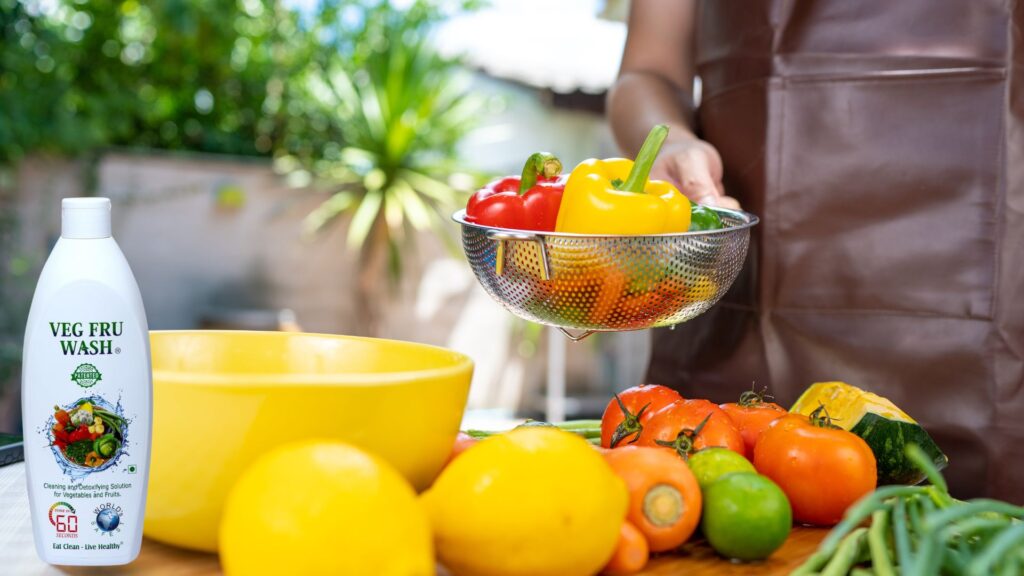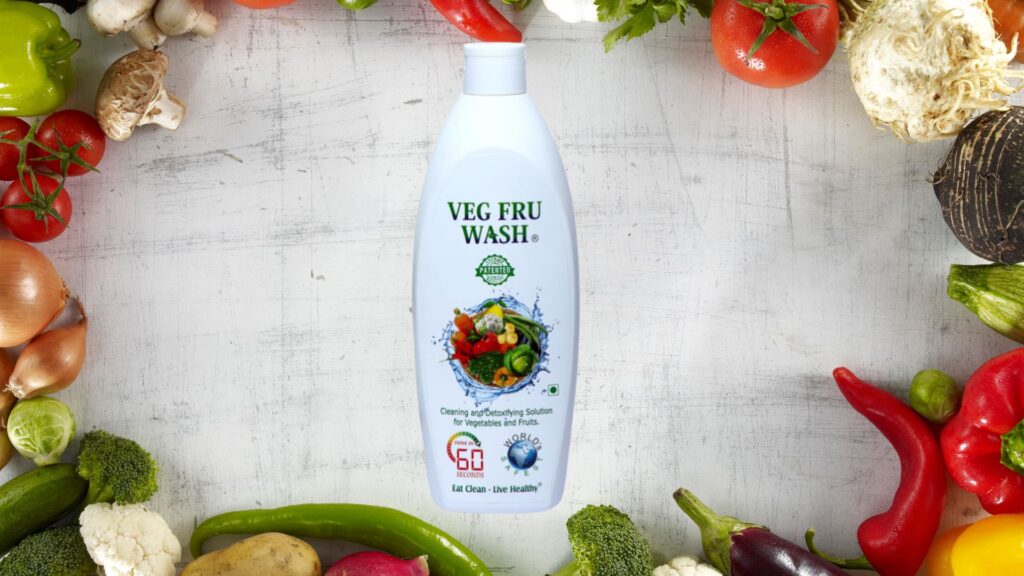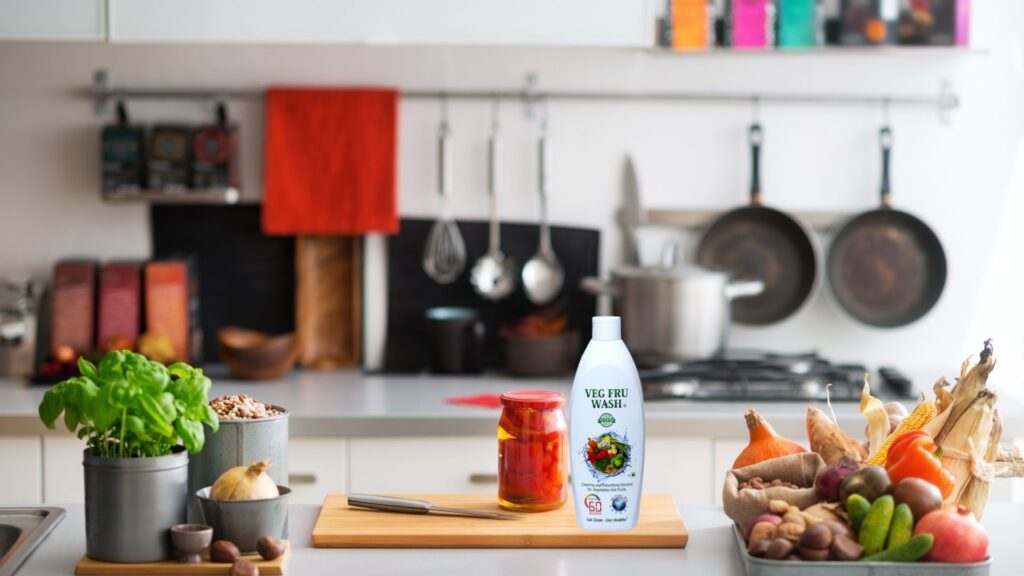
With increasing awareness about health and nutrition, fruits and vegetables have become an integral part of our daily diet. However, the journey from the farm to our tables exposes these vital foods to various contaminants, including pesticides, bacteria, and dirt. Ensuring that our produce is clean and safe to eat is crucial, and using a fruit and veggie wash can significantly help in this regard. This comprehensive guide will discuss the importance of fruit and veggie wash, its benefits, how to use it effectively, and practical tips for different types of produce.
The Necessity of Fruit and Veggie Wash
- Pesticide Residue Removal: Despite rigorous washing, pesticide residues can remain on the surface of fruits and vegetables. These chemicals, used extensively in agriculture to protect crops, can be harmful if ingested. A dedicated fruit and veggie wash is formulated to break down and remove these residues more effectively than water alone.
- Bacterial Contamination: Fruits and vegetables can be contaminated with harmful bacteria and pathogens such as E. coli, Salmonella, and Listeria at various stages of production and distribution. These microorganisms can cause serious foodborne illnesses. Using a fruit and veggie wash can significantly reduce the presence of these pathogens, ensuring safer consumption.
- Wax and Dirt Removal: Many fruits and vegetables are coated with a layer of wax to preserve freshness and improve appearance. This wax can trap dirt and bacteria. A fruit and veggie wash can dissolve this wax, making it easier to rinse away contaminants and ensuring that your produce is clean and safe.
Benefits of Using a Fruit and Veggie Wash
- Enhanced Cleaning Power: Compared to rinsing with water alone, a dedicated fruit and veggie wash is specifically formulated to penetrate and remove a broader range of contaminants, including pesticides, bacteria, wax, and dirt. This thorough cleaning ensures that your produce is safe and healthy to eat.
- Improved Taste and Texture: Clean produce not only tastes better but also has a more appealing texture. By removing contaminants, a fruit and veggie wash helps you fully enjoy the natural flavors and textures of your fruits and vegetables.
- Health Assurance: Knowing that your fruits and vegetables are thoroughly cleaned provides peace of mind. You can feel confident that you are minimizing the risk of exposure to harmful substances and providing safe, nutritious food for your family.
How to Use a Fruit and Veggie Wash Effectively
- Select the Right Product: Choose a fruit and veggie wash specifically designed for cleaning produce. Look for products that are natural, non-toxic, and free from harmful chemicals. These products are safe for both you and the environment.
- Follow Usage Instructions: Each product may have specific instructions for use. Typically, you will need to dilute the wash in water or spray it directly onto the produce. Follow the recommended guidelines to ensure optimal results.
- Soak and Scrub: For produce with tough skins, such as apples, potatoes, and carrots, soak them in the wash solution for a few minutes and then scrub with a vegetable brush. This helps remove stubborn dirt and contaminants.
- Rinse Thoroughly: After using the wash, rinse the produce thoroughly under cold running water. This helps remove any remaining residues from the wash itself, ensuring that your fruits and vegetables are safe to eat.
- Dry Properly: After washing and rinsing, dry your produce with a clean cloth or paper towel. This step helps remove any lingering bacteria and reduces moisture that can promote bacterial growth during storage.
Specific Tips for Different Types of Produce
- Leafy Greens: Separate the leaves and rinse them individually after soaking in the wash solution. This ensures that all parts of the greens are thoroughly cleaned. Leafy greens often harbor dirt and insects, making thorough washing essential.
- Berries and Soft Fruits: Place delicate berries in a colander and rinse gently after soaking in the wash solution. Be careful not to soak them for too long, as they can absorb water and become mushy. Soft fruits like strawberries, raspberries, and blueberries require gentle handling to avoid damage.
- Root Vegetables: Scrub root vegetables like beets, carrots, and potatoes with a brush after soaking. This helps remove embedded dirt and contaminants effectively. Root vegetables often have more dirt due to their growth in soil, making thorough cleaning necessary.
- Cruciferous Vegetables: Soak vegetables like broccoli and cauliflower in the wash solution to remove dirt and insects hiding in the crevices. Rinse thoroughly afterward to ensure all contaminants are removed. These vegetables have many nooks and crannies where dirt can hide, so soaking is particularly effective.
- Herbs: Fresh herbs can also carry dirt and bacteria. Rinse them under cold running water after soaking in the wash solution and pat them dry with a clean cloth or paper towel. Herbs like cilantro, parsley, and basil need gentle cleaning to avoid bruising.
Additional Considerations
- Organic Produce: Even organic fruits and vegetables can benefit from a thorough wash to remove dirt, bacteria, and any residual organic pesticides. While organic produce is grown without synthetic pesticides, it can still be exposed to contaminants during handling and transport.
- Homemade Wash Solutions: If you prefer a DIY approach, you can create your own wash solution using natural ingredients such as vinegar, lemon juice, or baking soda. However, be sure to rinse thoroughly to remove any remaining solution. A common homemade wash involves mixing one part vinegar with three parts water.
- Frequency of Washing: Make it a habit to wash all fruits and vegetables before consumption, regardless of whether they will be eaten raw or cooked. This ensures maximum cleanliness and safety. Washing produce before storing can also help remove any contaminants that might spread during storage.
Conclusion
Using a dedicated fruit and veggie wash is a crucial step in ensuring the safety and quality of your produce. By effectively removing pesticides, bacteria, wax, and dirt, you can enjoy cleaner, healthier, and more delicious fruits and vegetables. Incorporating this practice into your routine not only enhances the taste and texture of your produce but also provides peace of mind knowing that you are consuming safe and nutritious food. Make it a part of your daily routine to wash all your produce thoroughly, and enjoy the benefits of clean, safe, and healthy fruits and vegetables.


